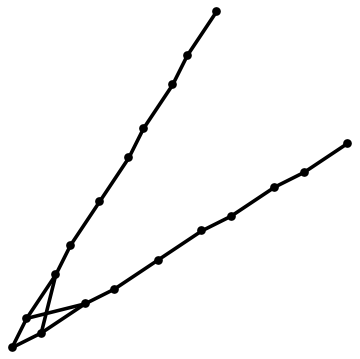The Lomonosov Tournament: Games Contest
A combinatorial games section? At a math competition? I have never heard of it before. But here it is, at the Lomonosov Tournament. The first problem is from the 2012 Tournament (the link is to a Russian version). The problem is by Alexander Shapovalov. I picked it for its elegance and simplicity.
A rectangular band. You have a paper rectangle of size m by n with grid lines, where both m and n are greater than 1. Two players play the following game. The first player cuts the rectangle along any grid line into two rectangles. The next player picks one of the rectangles and cuts it again along a grid line, and so on. The winner is the player who, after their move, can arrange all the rectangles into a band of width 1. Which player is guaranteed a win regardless of the moves of their partner? Consider two cases.
- One of the numbers, m or n, is even;
- Both m and n are odd.
The next problem, by I. Raskin, is from the 2015 Tournament (in Russian). The problem is about fruits, and I know a lot of great puzzles with bananas and oranges, so I immediately got attracted to this one.
The original version had three types of fruit starting with the letters a, b, and c in Russian. They were oranges, bananas, and plums. I reused bananas and replaced oranges with apples, but I got stuck on the letter c. The players in this game eat their fruits, so using cantaloupes seemed like overkill. Plus, I am on a diet, so I decided on cherries.
Fruits. There are a apples, b bananas, and c cherries on the table. Two players play a game where one move consists of eating two different fruits. The person who can’t move loses. Assuming the players use their best strategies, would the first or the second player win in the following cases?
- a = 1 (the answer might depend on the values of b and c);
- a = 6, b = 8, c = 10;
- a = 7, b = 9, c = 15;
- a = 19, b = 20, c = 21.
The last problem is from the 2012 Tournament (in Russian). It has great sentimental value for me, as it was created by John Conway. It also reminds me of the famous Frobenius (chicken McNugget) problem.
Coin mintage. Once upon a time, in a faraway kingdom, two treasurers were minting coins. They decided to make it into a game, taking turns minting coins. Each turn, the player chooses a particular integral denomination and mints an infinite supply of coins of this denomination. The rules of the game forbid choosing a new denomination that can be paid with the existing coins. The treasurer who is forced to mint a coin of denomination 1 loses.
- Prove that if the first treasurer starts with denomination 2 or 3, s/he loses.
- Is it profitable for the first treasurer to start with denomination 4?
- Is it profitable for the first treasurer to start with denomination 6?
- Suppose the first treasurer minted coins of denomination 5, and the second treasurer of denomination 6. What is the winning strategy for the first treasurer after that?
- Suppose the first treasurer minted coins of denomination 5, and the second treasurer of denomination k. Prove that the largest denomination available for minting is 4k − 5.
- Prove that the first treasurer can win by starting with denomination 5. (Hint: Suppose the second treasurer replied with denomination k, and the first treasurer minted 4k − 5 after that. If this strategy wins, the problem is solved. However, if after that, the second treasurer wins by minting denomination m, then minting denomination 4k − 5 was the wrong move. What was the right move?)
Share:









